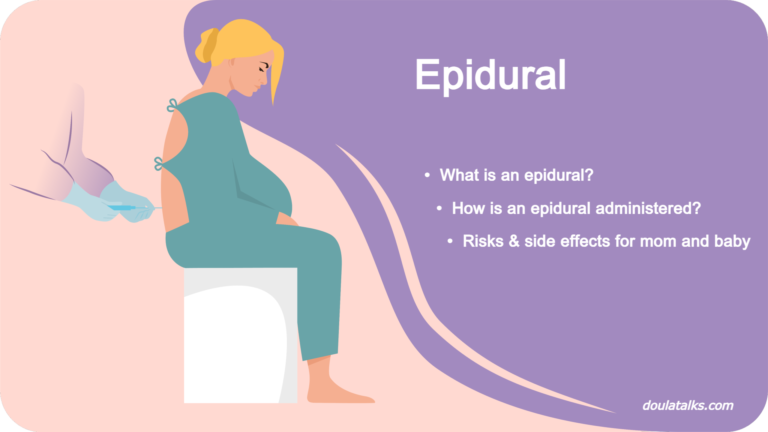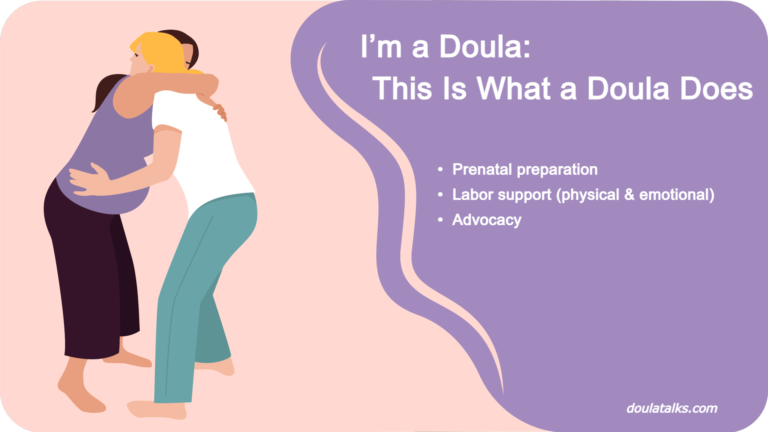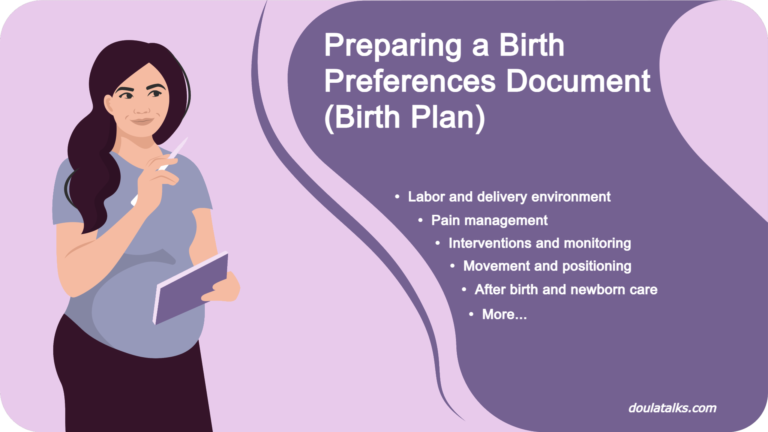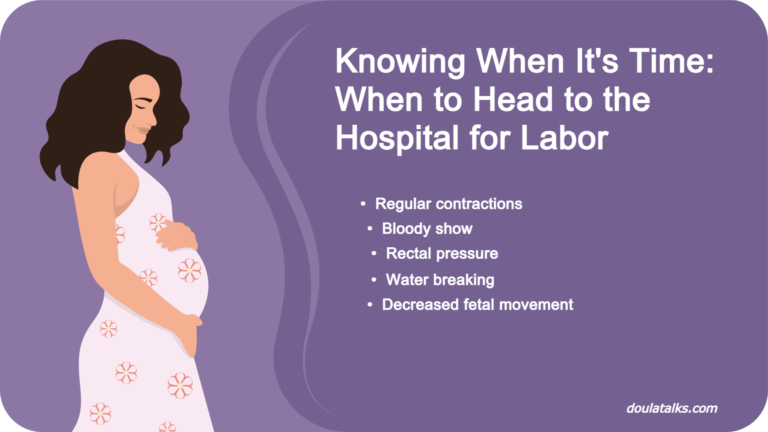VBAC (Vaginal Birth After Cesarean)
During the many years that I have been a doula, there has been an amazing shift from not even considering VBAC, to an understanding and agreement that VBAC is the preferred way to give birth when medically possible. Let’s explore what exactly a VBAC is, whether it is safe, how to prepare for one, and common questions about this method of birth.
By Liat Salomon, doula
April 22, 2025

In This Article:
- What is VBAC?
- Conditions for having a successful VBAC
- Is VBAC safer than repeat cesarean?
- VBAC risks
- Tips for preparing for a VBAC
- Can a baby be too big for VBAC?
- Can I get an epidural during a VBAC?
- Induction of labor for a VBAC
- Can you go past your due date with a VBAC?
- Length of time between pregnancies before attempting a VBAC
- How long is a hospital stay after VBAC?
- VBAC-2
- On a final note
What is VBAC?
VBAC stands for Vaginal Birth After Cesarean. It refers to a type of birth in which a woman who has had a previous cesarean delivery, also known as a C-section, attempts to give birth vaginally in a subsequent pregnancy.
In the past, it was common for women who had a C-section to have all subsequent deliveries via C-section as well. However, in recent years, there has been a growing trend toward attempting VBACs, as research has shown that not only is VBAC a safe and viable option for many women but a vaginal birth is the healthiest and preferred way to give birth. The American College of Obstetricians and Gynecologists (ACOG) recommends that women with a low-transverse uterine incision and no contraindications attempt a VBAC. Studies suggest that the success rate of VBACs ranges from 60% to 80%, with some studies reporting success rates as high as 90% in certain populations.
I know from personal experience that while VBAC can be a safe and effective option for many women, some hospitals and healthcare providers may have policies or personal preferences that discourage or limit VBAC. I strongly believe that you should have a conversation with your provider about it to make sure you have the right support when attempting a VBAC.
Another important thing that I feel needs to be said, as well: Some women may prefer a repeat C-section for scheduling reasons or because they feel more comfortable with a planned surgical delivery. That is a valid decision, too.
In this post, I will try to answer some of the most common VBAC questions and concerns.
Also Read:
Conditions for having a successful VBAC
Whether or not a woman is a good candidate for VBAC depends on several factors, including the reason for the previous C-section, the type of incision used, and the risk of uterine rupture.
A prior successful vaginal delivery
- Women who have had a previous vaginal birth are more likely to have a successful VBAC.
The type of uterine incision
- Low-transverse incisions (often called a bikini cut, a low-transverse incision is horizontal (side-to-side) and low on the uterus) are associated with a lower risk of uterine rupture during a subsequent vaginal delivery.
Reason for the previous C-section
- Women who had a previous C-section for non-recurring reasons, such as breech presentation or fetal distress, are more likely to have a successful VBAC than those who had a C-section due to cephalopelvic disproportion or failed induction.
Single fetus
- While VBAC with twins is generally considered safe and feasible for many women, the chance of a successful VBAC is slightly lower than that of when having a single fetus.
Good health
- Women with certain medical conditions or pregnancy complications may not be candidates for VBAC.
Is VBAC safer than repeat cesarean?
I get a lot of questions and concerns regarding the safety of trying for a VBAC.
Both VBAC and repeat cesarean delivery carry risks and benefits, and the safety of each option depends on the individual circumstances of the woman.
In general, VBAC is considered a safe option for many women who have had a previous cesarean delivery and meet certain criteria. However, there is a small risk of uterine rupture during a VBAC, which can be life-threatening for both the mother and baby.
A repeat C-section also carries risks, such as the potential for surgical complications, longer hospital stays, and a longer recovery time. Additionally, a repeat C-section may increase the risk of placenta previa, placenta accreta, and other complications in future pregnancies.
VBAC risks
As mentioned before, there are some risks associated with VBAC that need to be considered.
As mentioned, the main risk associated with VBAC is uterine rupture, which is a tear in the uterus that can lead to serious complications for both the mother and the baby. The risk of uterine rupture during VBAC is estimated to be around 0.5% to 1%, although this risk may be higher in certain situations, such as if the previous C-section incision was a classical or T-shaped incision.
Other factors that may increase the risk of complications during VBAC include maternal obesity, advanced maternal age, and medical conditions such as hypertension or diabetes. I feel that with careful monitoring and appropriate medical management, many women can safely have a successful VBAC.
If uterine rupture does occur during VBAC, prompt diagnosis and emergency care are essential to minimize the risk of maternal and fetal complications. This may involve an emergency C-section and other medical interventions as needed.
To prevent uterine rupture during VBAC, healthcare providers may recommend the following:
- Close monitoring: Women attempting a VBAC may be asked to be monitored more during active labor.
- Induction of labor: Women attempting a VBAC may be advised to avoid induction of labor as this can increase the risk of uterine rupture. However, in some cases, induction of labor may be necessary for medical reasons, and this should be managed carefully.
- Avoidance of labor augmentation: Labor augmentation, such as the use of Pitocin to increase contractions, may also increase the risk of uterine rupture during a VBAC, and should be used with caution.
- Women with certain medical conditions, such as a history of multiple previous C-sections or a large baby, may be advised against attempting a VBAC. However, the decision should be made based on the specific individual condition of each woman.
Tips for preparing for a VBAC
Over the years I helped many people have wonderful VBACs and gathered a few tips along the way.
Preparing for a VBAC requires a combination of physical, emotional, and practical preparation. Here are some steps you can take to help prepare for a successful VBAC:
- Educate yourself about VBAC: Learn as much as you can about VBAC, including the risks and benefits, the potential complications, and how to prepare for a successful VBAC. Consider attending childbirth education classes or working with a doula or other childbirth educator who has experience with VBAC.
- Prepare your body for labor: Exercise regularly, eat a well-balanced diet, practice pelvic floor exercises, and manage stress to help prepare your body for labor and delivery. You may also wish to consider using relaxation techniques such as deep breathing or visualization during labor.
- Discuss your previous C-section with your healthcare provider to better understand why it was performed, the type of incision used, and any potential risks or complications that may impact your ability to have a VBAC.
- Choose a supportive birth environment: Consider choosing a hospital or birth center that has a supportive VBAC policy and staff who are experienced in VBAC. You may also wish to consider using a birthing tub, birth ball, or other comfort measures during labor.
- Write a birth preference document: Make a list of preferences that reflect your wishes for labor and delivery, including your preferences for pain management, labor positions, and any other concerns or preferences you may have.
- Be flexible and open-minded: Remember that birth is unpredictable and sometimes plans change. Be open to the possibility that a C-section may be necessary for the safety of you and your baby, and make sure to discuss your preferences and concerns with your healthcare provider throughout labor and delivery.
- Consider hiring a doula: A doula is a trained professional who provides emotional and physical support during labor and delivery. A doula can help you navigate the challenges of labor and advocate for your preferences.
Remember that every woman’s body is unique and that there is no guaranteed way to have a successful VBAC. However, with careful preparation, a supportive healthcare team, and a positive attitude, many women can successfully have a VBAC and achieve the birth experience they desire.
Can a baby be too big for VBAC?
The size of the baby is one of many factors that may be considered when assessing a woman’s suitability for VBAC. However, there is no clear consensus on what size is “too big” for VBAC.
In general, healthcare providers may be more cautious about recommending VBAC for women who have a history of giving birth to larger babies or who are carrying a larger-than-average baby. This is because larger babies may have difficulty passing through the birth canal, which can increase the risk of complications such as shoulder dystocia, a condition in which the baby’s shoulders become stuck during delivery. However, I have seen easy “big baby” VBACs and difficult “small baby” VBACs, so the size of the baby cannot be the only deciding factor in whether or not to attempt a VBAC. Remember that before birth, there is only an estimate of the baby’s size, and those numbers can be inaccurate.
Can I get an epidural during a VBAC?
I get this question a lot, and honestly, there is no one good answer. Whether or not to have an epidural during a VBAC is a personal decision that should be based on a woman’s individual needs and preferences.
An epidural can help manage pain during labor and delivery; however, some women may prefer to avoid an epidural to stay more alert and active during labor and to have more control over their pushing efforts.
It’s important to note that having an epidural during a VBAC may slightly increase the risk of certain complications, such as uterine rupture, compared to a natural or medicated vaginal birth, but this risk is generally considered low and many women who have had a previous C-section are able to safely have an epidural during a VBAC.
Induction of labor for a VBAC
I find that an induction of labor for a VBAC is a complex issue that should be carefully considered. In general, induction is not recommended for VBACs unless there is a clear medical reason for it, such as pre-eclampsia, gestational diabetes, or other conditions that could threaten the health of the mother or baby.
An induction can increase the risk of certain complications, such as uterine rupture. For this reason, many healthcare providers suggest that a VBAC progresses naturally, without intervention, as long as the mother and baby are healthy and there are no complications.
If induction is deemed necessary for a VBAC, there are certain guidelines that must be followed to minimize the risk of complications. For example, the use of prostaglandins to soften the cervix should be avoided as they can increase the risk of uterine rupture. Instead, a low-dose Pitocin may be used to stimulate contractions, but only under close monitoring.
Overall, the decision to induce labor for a VBAC should be made on a case-by-case basis, taking into account the individual circumstances and medical history of the woman and her baby.
Can you go past your due date with a VBAC?
I want to start my answer by reminding you that a “due date” is only an estimation and not a set-in-stone date.
The timing of delivery for a VBAC is generally similar to that for a first-time vaginal delivery. Most women who have had a previous C-section can safely go past their due date and have a VBAC if labor starts naturally.
It is important to note that the risk of certain complications, such as uterine rupture, may increase slightly as pregnancy progresses beyond the due date. Therefore, many healthcare providers will recommend inducing labor or scheduling a C-section if the pregnancy goes beyond 41 weeks, or earlier if there are other medical concerns.
Ultimately, the decision about when to deliver a baby for a VBAC should be made based on a careful consideration of the risks and benefits, considering the individual circumstances and medical history of the specific woman and her baby.
Length of time between pregnancies before attempting a VBAC
In general, it is recommended to wait at least 18 months after a C-section before attempting a VBAC, as this allows time for the uterus to heal and reduces the risk of complications.
If you have certain medical conditions or other risk factors, your provider may recommend waiting longer or not attempting a VBAC at all.
How long is a hospital stay after VBAC?
The length of hospital stay after a VBAC depends on the type of delivery. In general, women who have had a successful VBAC with no complications may be able to go home within 24 to 48 hours after delivery, as long as both they and their babies are doing well.
If there are any complications during or after the delivery, the length of the hospital stay may be longer. For example, if the mother had a uterine rupture during the delivery or if the baby has any health concerns that require monitoring, they may need to stay in the hospital for a few more days.
VBAC-2
VBAC-2 refers to a woman who had two previous C-sections and is attempting a vaginal birth for her third delivery.
VBAC-2 is generally considered to be more challenging and carries more risks than a VBAC for women who have had only one previous C-section. This is because each C-section increases the risks, such as uterine rupture, placenta previa, or placental abruption.
The success rate of VBAC-2 is lower than for VBAC after one previous C-section. The ACOG estimates that the success rate for VBAC-2 is around 60%-70%, compared to a success rate of as much as 80% for VBAC after one previous C-section.
The risks associated with VBAC-2 include:
Uterine rupture
- The risk of uterine rupture during VBAC-2 is higher than for a VBAC after one previous C-section. According to ACOG, the risk of uterine rupture during VBAC-2 is estimated to be around 1%-3%.
Placenta previa
- The risk of placenta previa (a condition in which the placenta covers the cervix) is higher for women who have had multiple previous C-sections, and this can increase the risk of bleeding during delivery.
Abnormal placentation
- Women who have had multiple previous C-sections are also at higher risk of abnormal placentation, a condition in which the placenta attaches too deeply into the uterus. This can increase the risk of bleeding and other complications during delivery.
With careful monitoring and appropriate medical management, many women can safely have a successful VBAC-2.
On a final note
In conclusion, a VBAC is generally considered a safe option for women who have had a previous C-section, and most babies born during a VBAC do not experience any serious complications. Take the appropriate preparation steps and speak with your healthcare provider about your desire for a VBAC to have a successful delivery.
I wish you a wonderful and happy birth!
Questions?
If you have any questions about this topic/article, please feel free to contact me through email at: liat@doulatalks.com
Liat Salomon is a certified doula since 2010 and is working in the San Francisco Bay Area in California. She has assisted in hundreds of births and has extensive experience with VBAC.
The information in this article does not constitute medical advice or diagnosis. It is meant for informational purposes only.
Related Articles:
Conclusion
The decision to use pain medication during labor is personal, and, if requested, the different medications should be used in different stages of labor.
I feel that, when possible, a natural birth is a practical decision, because of the many advantages it has (usually shorter, healthier birth, shorter pushing stage, less tearing, easier recovery, impact on nursing, diminished likelihood or severity postpartum depression) – but an epidural should not be considered “a devil”. It is a tool, and like any tool, with proper knowledge, it can be used safely and effectively.










